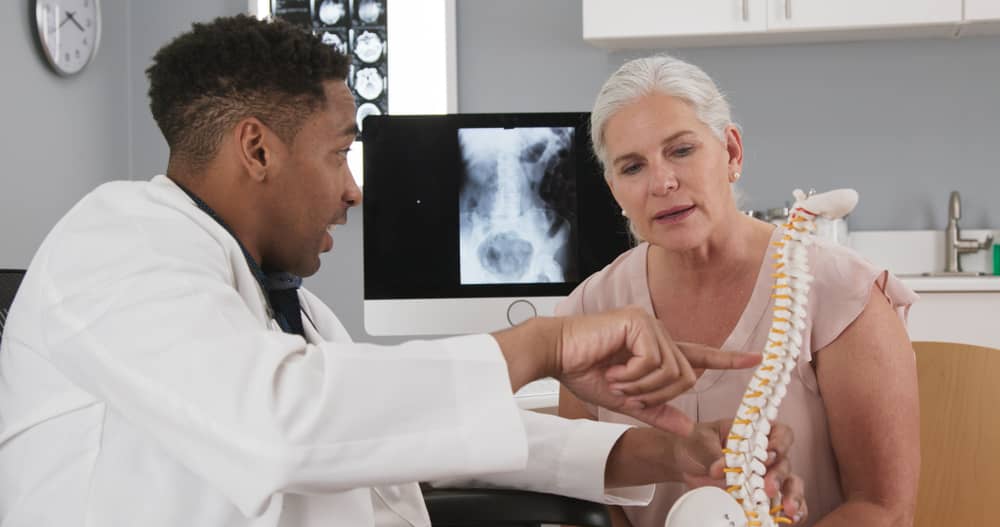Mineral & Bone Disorder in Chronic Kidney Disease
On this page:
- What is mineral and bone disorder in chronic kidney disease (CKD)?
- What causes mineral and bone disorder?
- How common is mineral and bone disorder?
- Who is more likely to have mineral and bone disorder?
- What are the complications of mineral and bone disorder?
- What are the symptoms of mineral and bone disorder?
- How do health care professionals diagnose mineral and bone disorder?
- How do health care professionals treat mineral and bone disorder?
- Can I prevent mineral and bone disorder?
- Clinical Trials for Mineral and Bone Disorder
What is mineral and bone disorder in chronic kidney disease (CKD)?
Mineral and bone disorder in chronic kidney disease (CKD) is a disorder that can affect the bones, heart, and blood vessels of a person with CKD. Mineral and bone disease occurs when kidneys damaged by CKD can’t filter blood and regulate hormones the way they should. The hormone levels and levels of minerals, such as calcium and phosphorus, then become imbalanced, leading to damage.
Does mineral and bone disorder have other names?
Mineral and bone disorder in CKD is also called CKD Mineral and Bone Disorder, or CKD-MBD.
The bone disease component of mineral and bone disorder is called renal osteodystrophy.
Why are hormones and minerals important?
Healthy bones continuously rebuild. Hormones and minerals help bones stay strong. If your hormones and minerals are out of balance, your bones can become weak and misshapen.
To grow and rebuild, bones need
What role do the kidneys play in hormone and mineral balance and bone growth?
Your kidneys play an important role in maintaining healthy bone mass and structure by
- balancing calcium and phosphorus levels in your blood
- activating a form of vitamin D that you get from food and turning it into a form, called calcitriol, that your bones can use
- removing extra phosphorus from your blood by passing it out in urine
- sending phosphate and calcium back into your bloodstream from the kidneys and bones when more is needed
What causes mineral and bone disorder?
Kidney damage from CKD causes mineral and bone disorder because the damaged kidneys do not properly balance the mineral and hormone levels in the body. Damaged kidneys stop
- turning vitamin D into calcitriol, creating an imbalance of calcium in your blood
- removing excess phosphorus from your blood, triggering your blood to pull calcium out of your bones and causing them to weaken
Also, when your kidneys are damaged, your parathyroid glands, which are located in your neck but are not related to your thyroid function, release extra PTH into your blood to move calcium from your bones to restore your blood calcium levels; but this response also starves your bones of much-needed calcium.
How common is mineral and bone disorder?
More than 37 million Americans—about 1 in 7 adults—are estimated to have CKD. Anyone with CKD is likely to have some level of mineral and bone disorder.1 As kidney function declines, mineral and bone disorder progresses. The disorder is almost always found in the more than 785,000 Americans who have kidney failure and are either on dialysis or had a kidney transplant.2
Who is more likely to have mineral and bone disorder?
Mineral and bone disorder is more common in people with CKD who have kidney failure and are on dialysis.
People who have kidney failure—and whose mineral and bone disorder is more evident—are more likely to be1
- women
- age 65 or older
- non-Hispanic Black
People who do not follow the kidney diet, do not take their phosphate binder medications, or do not stay on dialysis for the full prescribed time will have more severe CKD-MBD.
What are the complications of mineral and bone disorder?
The complications of mineral and bone disorder include
- slowed bone growth and bone deformities
- bone fractures
- heart and blood vessel problems
People who experience these complications may have a poorer quality of life, may spend more time in the hospital, and have a higher risk of fractures or death.3
Slowed bone growth and bone deformities
Damaged kidneys must work harder to remove phosphorus from your body. Buildup of phosphorus is associated with less calcium in your blood and with the release of PTH by your parathyroid glands. PTH moves calcium out of your bones and into your blood. The loss of calcium can harm your bones.
Complications could include
- slowed bone growth, leading to short stature that may remain into adulthood
- a deformity sometimes called “renal rickets”, in which the legs bend inward or outward
- increased likelihood of bone fractures
Bone fractures
If you’re an adult with mineral and bone disorder, and the condition remains untreated, your
- bones gradually become thin and weak.
- bones and joints may begin to feel painful.
- risk of developing low bone mineral content, called osteoporosis, increases. If severe, osteoporosis may increase your likelihood of fractures or broken bones.
 If you have CKD, your health care professional will look for changes in your bone structure.
If you have CKD, your health care professional will look for changes in your bone structure.
Heart and blood vessel problems
Mineral and bone disorder can not only harm your bones. It can also increase your risk of heart attacks, strokes, and death.
- High levels of blood calcium can damage your blood vessels and lead to heart problems.
- High levels of phosphorus can
- cause your blood vessels to harden—a process known as calcification.
- cause abnormal hormone regulation, even if your calcium level is acceptable.
- High levels of PTH and another hormone made in the bones, called FGF23, can also harm both your bones and your heart and blood vessels.
What are the symptoms of mineral and bone disorder?
Adults with mineral and bone disorder may feel bone and joint pain. However, these symptoms may not appear until a person has had the disorder for many years.
In children, mineral and bone disorder is particularly serious because their bones are still developing and growing. Unlike adults, children can show visible bone changes from mineral and bone disorder in the early stages of CKD. For example, they may not grow as expected—a condition known as growth failure—or their bones may become weak from lack of calcium.
How do health care professionals diagnose mineral and bone disorder?
Your health care professional diagnoses mineral and bone disorder with
- a family and medical history to determine when you were first diagnosed with CKD and whether any family members also had mineral and bone disorder
- a physical exam to look for any changes in bone structure
- a blood test to check levels of calcium, phosphorus, PTH, and sometimes vitamin D
- rarely, a sample or biopsy of the bone to check bone density and structure
- sometimes, an x-ray to look at bone structure and inconsistencies
- bone density testing and computed tomography (CT) scans of the bones and to look for calcification in the heart
Each of these tests can help your health care professional find out whether CKD or some other condition is causing the mineral and bone disorder and to determine a course of treatment.
 Your health care professional will ask about your CKD medical and family history.
Your health care professional will ask about your CKD medical and family history.
How do health care professionals treat mineral and bone disorder?
Treatment for mineral and bone disorder aims to control mineral and hormone levels to prevent bone and blood vessel damage. Your health care professional may
- suggest changes to what you eat and drink
- prescribe medicines and supplements
- start you on dialysis
- recommend a kidney transplant
- recommend surgery to remove the parathyroid glands that produce hormones
Eating, diet, and nutrition
Changing what you eat and drink can help treat mineral and bone disorder. Eating fewer foods that contain phosphorus is one of the most important steps to help you prevent bone disease and blood vessel calcification.
Most foods contain some phosphorus. However, most processed and packaged foods, such as lunch meats and canned or boxed foods, contain high levels. Food producers use phosphorus as a food preservative. If you have CKD or are on dialysis, avoid packaged foods containing ingredients that include the letters “PHOS.”
Medicines and supplements
Medicines protect your bones and blood vessels by restoring the proper balance of minerals and hormones. If your kidneys don’t make adequate amounts of calcitriol, your health care professional may prescribe a variety of medicines, such as
- synthetic calcitriol to reduce PTH levels
- a calcium supplement and vitamin D
- calcimimetics to lower your PTH levels or to treat secondary hyperparathyroidism
- phosphate binders, which bind to the phosphorus in food and keep it from being absorbed by your intestines
Talk with your health care professional before using alternative medicines, including vitamin and mineral supplements.
 Talk to your health care professional about medicines and supplements, available by prescription or over the counter, that might protect your bones and blood vessels.
Talk to your health care professional about medicines and supplements, available by prescription or over the counter, that might protect your bones and blood vessels.
Dialysis
If your kidneys no longer filter wastes and extra fluids from your body, your health care professional might recommend dialysis. The two forms of dialysis are hemodialysis and peritoneal dialysis.
If you require dialysis, your health care team will monitor and adjust your nutrition, medicines, and supplements based on your ongoing blood tests. If you receive a kidney transplant, your team will reevaluate your nutrition and medicine.
Parathyroidectomy
If diet, medicines, and dialysis can’t control your PTH levels, a surgeon can remove one or more of your parathyroid glands.
Can I prevent mineral and bone disorder?
Mineral and bone disorder can’t be prevented, but you can delay its start and slow down its progression by protecting your kidneys and improving your bone and vascular health. Make healthy food choices, stay active, quit smoking, and limit how much alcohol you drink. Take medicines as prescribed, and check in with your health care professional to discuss treatment updates as your disease status changes. Finally, if you are on dialysis, complete all your treatments as prescribed by your health care professional.
Clinical Trials for Mineral and Bone Disorder
The NIDDK conducts and supports clinical trials in many diseases and conditions, including kidney diseases. The trials look to find new ways to prevent, detect, or treat disease and improve quality of life.
Researchers continue to look for other causes of mineral and bone disorder in CKD. For example, they are studying whether the disorder may be related to abnormal changes in a bone protein known as collagen.
What are clinical trials for mineral and bone disorder?
Clinical trials—and other types of clinical studies—are part of medical research and involve people like you. When you volunteer to take part in a clinical study, you help doctors and researchers learn more about disease and improve health care for people in the future.
Find out if clinical trials are right for you.
Watch a video of NIDDK Director Dr. Griffin P. Rodgers explaining the importance of participating in clinical trials.
What clinical trials for mineral and bone disorder are looking for participants?
You can view a filtered list of clinical studies on mineral and bone disorder in CKD that are open and recruiting at ClinicalTrials.gov. You can expand or narrow the list to include clinical studies from industry, universities, and individuals; however, the National Institutes of Health does not review these studies and cannot ensure they are safe. Always talk with your health care provider before you participate in a clinical study.
References
This content is provided as a service of the National Institute of Diabetes and Digestive and Kidney Diseases
(NIDDK), part of the National Institutes of Health. NIDDK translates and disseminates research findings to increase knowledge and understanding about health and disease among patients, health professionals, and the public. Content produced by NIDDK is carefully reviewed by NIDDK scientists and other experts.
The NIDDK would like to thank:
Sharon Moe, M.D., Indiana University School of Medicine

